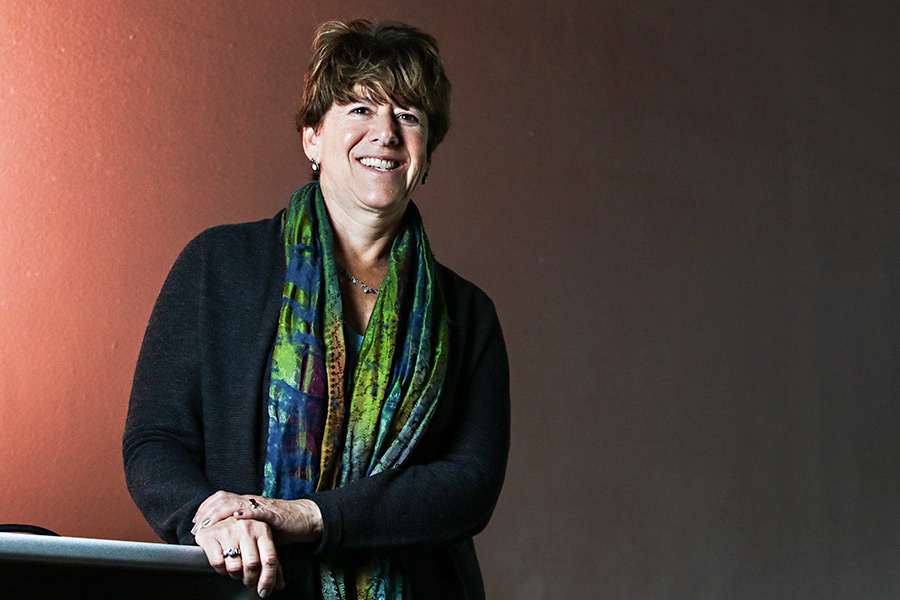Last month, the new owner of two of the valley’s historic timber mills — Weyerhaeuser Co. — shuttered operations at the facilities. The Washington-based company laid off 72 mill workers alongside another 100 who were ushered out of administrative positions in recent months.
The closures delivered a hit to the local economy and a painful blow to the families involved, some of whom had worked multiple generations in the timber trade.
Faced with the sudden news and uncertainty over the future, the Columbia Falls workers received a special presentation before being let go. Staff members from Flathead Valley Community College arrived at the timber mills with folders filled with information and resources. They handed out pamphlets detailing the more than 100 academic programs offered at the Kalispell campus, including several industrial and occupational certifications for welding, machine operations and other trades. They provided testimonials from students of all ages, including middle-aged men and women who had abruptly lost their jobs but returned to college and gained a fresh start in a new career. And the college representatives gave out financial aid forms highlighting the affordability of attending school — roughly $4,100 a year for Flathead and Lincoln county residents — and the large amount of community support, which surpasses $800,000 a year, that goes toward scholarships.
“We know, certainly, if you haven’t been in school for a while, whether it’s high school or college, it’s pretty intimidating to have to come onto a college campus,” FVCC President Jane Karas said. “So we went there to talk to them and show that we’re geared to them and their needs.”
“As a community college,” she added, “our mission is to meet the needs of the local community, and so whatever areas the community needs support in, that’s our job to meet those.”
The quick and thorough response to the Weyerhaeuser layoffs was the latest example of FVCC fulfilling its mission of helping the community address the gamut of challenges and needs that can suddenly arise. In the heart of the recent recession, the community college dramatically increased its programs in response to a 55 percent enrollment growth that saw the student population spike to nearly 2,800, making FVCC the fourth largest of any college or university in Montana. At the same time, as a substantial number of veterans returned home from service overseas, the college made room for a new Veterans’ Center in 2014, hoping to provide added resources and assistance for VA benefits, college-related issues and civilian matters.
This fall, despite the economic recovery, the college remains as relevant as ever. Enrollment remains robust with more than 2,263 full-time and part-time students taking classes this semester, a 4.3 percent increase over last year. Roughly 43 percent of the student body is non-traditional, meaning 27 or older, while the number of local high school graduates attending FVCC has risen in the last decade. The slate of two-year academic programs, four-year partnerships with other state universities, professional certifications and non-credit community continuing education classes keeps expanding as well. Also, construction is underway on a $7.7 million student housing facility with 124 beds, which is expected to be finished next summer.
“Fifty years ago, I think a lot of people knew the importance of having education here, but I don’t know if they realized what a difference they were going to make,” Karas said. “I often say it’s like the Jimmy Stewart movie, ‘It’s a Wonderful Life.’ What would this community be like if the college never existed? It would be a very different place, I think. It would still be a beautiful place and we would still have a lot of great people here. But I think the college has truly made a difference in a lot of lives.”
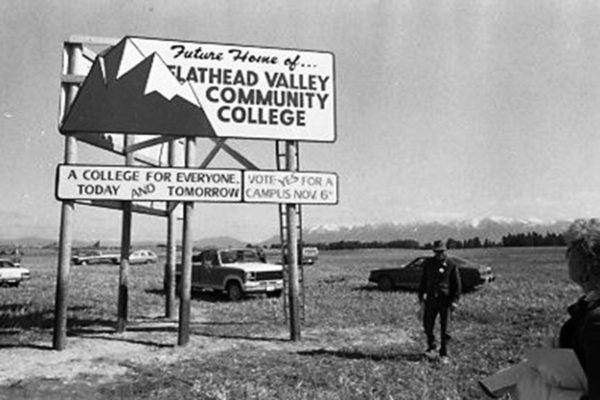
Bill McLaren, 88, remembers it like it was yesterday. It was the late 1950s and McLaren was a counselor at Flathead High School. He began interviewing seniors before graduation and asked them a simple yet important question: What are your plans after high school?
As McLaren recalls, most of the boys said they planned to stick around the valley and find work in the timber industry or in some other blue-collar endeavor, following in their fathers’ footsteps. Most of the women planned on becoming stay-at-home mothers or work as a secretary or in other administrative positions.
“Most of them, when I mentioned college, they said they could never afford to go away to college. It was too expensive,” McLaren said recently.
In fact, only 20 percent of Kalispell seniors planned on attending college, according to McLaren’s research from 1952 through 1962. And among those, only about 7 percent were graduating with a four-year degree. In comparison, down the road in Missoula, where the University of Montana resided, roughly 40 percent of students were attending college and graduating with a degree.
McLaren presented the information to the local school board, led by chairman Owen Sowerwine.
“When I gave them my report, (Sowerwine) almost broke down and cried,” McLaren said. “He said, ‘We’ve got to do better than that.’”
Sowerwine, a well-known conservationist and community figure, took it upon himself to find an answer. Recently retired, Sowerwine spent the ensuing years traveling the country studying what other communities similar to the Flathead Valley were doing to improve their residents’ livelihoods through higher education. At first, his thought was for Kalispell to develop a junior college, which could provide education programs mostly for university transfer students.
Instead, Sowerwine discovered another phenomenon that was sweeping the nation. In the early 1960s, the community college model was a new and rapidly expanding movement that focused on post-secondary education linked to a community and its specific economic characteristics. By 1965, there were nearly 900 community colleges in the U.S. Instead of focusing on research, faculty members were principally tasked with providing high-quality instruction. Students could either gain two years of schooling that would vault them on to a four-year university, or they could take specialized courses that trained them for occupations right out of school, including engineering, technology and construction.
“Owen came back and said, ‘We don’t want a junior college. We need a community college. We need to take care of all of the students in our community, not just college transfer students,’” McLaren recalled.
Sowerwine organized a group of advocates and planners who would shape this dream and make it reality. He organized what is now known as the “Original Five:” McLaren; Norm Beyer, director of the local state employment agency; Thelma Hetland of the Federated Women’s Club; and Les Sterling, one of the owners of KOFI Radio.
Over the next few years, the group rallied support throughout the community, visiting with men’s and women’s civic groups and other residents to explain why a two-year college could have an immediate and lasting impact on locals of all ages and abilities. A majority of Flathead County voters needed to approve the request to fund the college.
The decision arrived on April 1, 1967, with news coverage from across the state reporting on the results. Late in the night, the tally came in — 3,013 in favor and 2,308 opposed.
Within a week, the newly elected board hired a president, Dr. Larry Blake, a Flathead High School graduate who had led other community colleges in the region. Blake’s first decision was to hire a dean of students, and he tabbed McLaren.
“He said he wanted me, and I said, ‘Larry, I don’t know anything about colleges.’ He said, ‘No, but you know the area and you know the students. That’s all that really matters,’” McLaren said.
The two men went to work. State funding was not slated to arrive until July, and the college was facing its first few months of organization without any financial support when an anonymous donor in the community gave Blake and McLaren $13,000 to cover the initial costs. Glacier Bank sent one of its officers, Leo Shepherd, to help figure out the accounting, which he did with the bank paying his salary.
In a night that is now legend, the three men — Blake, McLaren and Shepherd — met in the upstairs of the county library with a typewriter, a few folding chairs and the vision of a new community college. It was here that the dream transformed into reality.
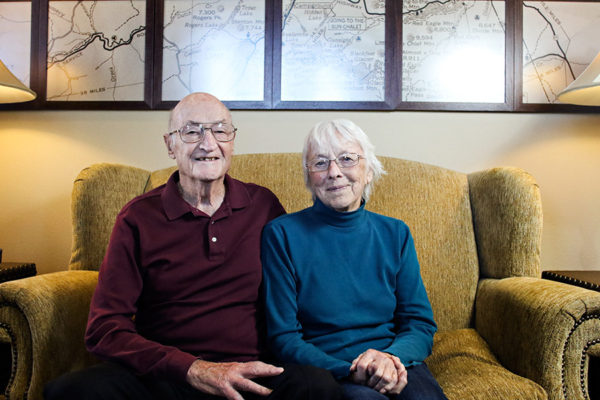
Excitement over the new college spread quickly. Sterling would advertise the new community college on the radio everyday while the curriculum grew to include practical college programs in business and forestry, among others, as well as 20 to 30 courses of general interest to adults, including homemaking, home repair and dance.
By fall, 611 students — a mixture of traditional students and community members — enrolled in classes at the new Flathead Valley Community College. Night classes were held at Flathead High School. Morning sessions were held at the VFW bar or in several local church basements. Years later, the college set up shop in various buildings on Main Street and eventually in Central School.
The administrative office was established inside the former train depot building downtown next to Depot Park, where the Kalispell Chamber of Commerce currently resides. McLaren and Blake set up their offices upstairs and turned the downstairs into a bookstore and center for students. That first semester, there were seven faculty members who taught courses, making it nine total with Blake and McLaren.
The faculty and their families did a little of everything in those early years. For example, McLaren’s wife, Lois, Blake’s wife and others often worked as custodians, cleaning classrooms at night or early in the morning.
Lois, a stay-at-home mother with four kids who had hoped to someday get a college education, also enrolled as a student and became part of the second graduating class at FVCC. The roughly 40 graduates that year marched through downtown and held a ceremony in the former Liberty Theater.
“It was a big step for a lot of people just to graduate high school because their parents probably didn’t,” Lois remembered recently. “There were six of us in our 40s. We were all a little afraid to go to college and compete with these kids in classes … I was going to attend (the University of Montana in Missoula), but we still had four kids at home and when the time came, I didn’t want to move … It was pretty isolated here. With the college, we were finding out there are things out there in the world that we didn’t know about. It’s changed the community, I think.”
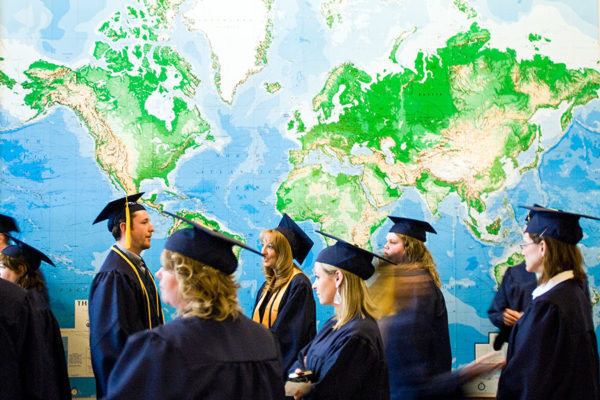
Fifty years later, FVCC, with its 216-acre sprawling campus on the north side of Kalispell, has a well-established tradition.
“From its earliest days, Flathead Valley Community College has been a tremendous asset to the businesses and citizens of Flathead County,” Kalispell Chamber of Commerce President Joe Unterreiner said. “From my perspective as the chamber president, there have been several initiatives at the college over the last few years that will have lasting benefits for our economy and the youth of our community.”
The college has followed its mission in numerous ways for students of all ages. The development of the Running Start Program has helped high school students earn college credits for course work and reduced costs for families while improving the chances for student success at the college level. Students in Flathead and Lincoln counties can receive six free college credits through the program. They can also participate in summer courses to gain an extra three to four credits.
“Flathead Valley Community College has been a cornerstone in our community and school,” Flathead High School Principal Peter Fusaro said. “They have always had the foresight to be able to respond to the needs of our community and the needs of our students. The Running Start program has had the greatest impact … We have found that students who take Running Start credits are twice as likely to go and be successful in college than those of their counterparts. It is truly an amazing program.”
“These opportunities not only prepare our students for college, but also for the workforce,” Fusaro added. “We congratulate FVCC on 50 great years and we look forward to continuing our partnership for the next 50 years and beyond.”
The growth of programs for non-traditional students, as well as professional certifications, has also made FVCC stand out in Montana’s educational landscape.
“FVCC is held aloft as a gold standard, certainly for community colleges but also for all colleges, as a school with innovative practices,” said Matthew Springer, project director of RevUp Montana, a statewide workforce project supported by federal grant money that partners with colleges to help increase vocational degree and certification training.
Springer said FVCC has pushed the envelope in a lot of areas by developing new programs and research that address specific needs in the Flathead Valley, such as industrial occupational trade sectors.
“They’re constantly seen as one of the entities that are pushing that work in Montana, and they’re certainly providing leadership in that,” Springer said.
Under the leadership of Karas, who is entering her 16th year as president and was recently named the top community college leader in the Pacific Northwest, FVCC has continued to grow with the community in mind. In recent years, the college has expanded its partnership with the University of Montana and Montana State University for four-year bachelor of arts degrees.
“I think the word about the college is getting out, that it’s a great place to start your education,” Karas said. “We have faculty who could teach anywhere in the world. They could teach at Harvard or Stanford, but because of where we live they’ve chosen to be here. They’re really focused on our students’ learning.”
Karas said the next five years could see the college expand with a new student center and fitness center at the large open campus along U.S. Highway 93.
“We listen — I meet with people in all different cities around Lincoln and Flathead counties,” she said. “We’re always focused on how we can help students be more successful. A lot of students are part-time students and they have a family and a job, or both. It’s a challenge just to be in school, but especially when you’re balancing work and a family. So for many of our students, it’s finding ways to support them, whether it’s financial assistance or counseling or just some ways to help bridge those challenges when they have them.”
The McLarens, who celebrated their 68th anniversary last week, both still attend the senior courses at the college — every Friday for six weeks in February and March — as they have for over 40 years.
“Bill takes the same course every year: watercolor. I’ve done Audubon, line dancing, computer, history,” Lois said last week, sitting next to her husband in Kalispell and reflecting on their lifetime of “enlightenment” at FVCC.
“I like to learn something different every year. There’s no excuse to be bored.”
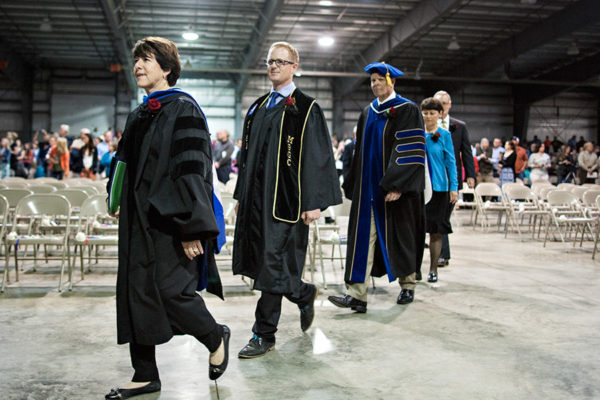
FVCC’s 50-Year Legacy
Late 1950s & Early 1960s
Owen Sowerwine, chairman of the Flathead County High School board and a well-known community and environmental advocate, begins envisioning plans for either a junior college or community college in Kalispell to help students and residents improve their economic opportunities. His friend, Bill McLaren, a counselor at Flathead High School, begins conducting surveys among seniors from 1952-1962 and finds only roughly 20 percent of graduates were going on to attend college, and among those only 7 percent completed their four-year education. In contrast, Missoula, home to the University of Montana, had over half the graduates attending college and 40 percent were completing a degree.
Mid 1960s
Sowerwine and McLaren band together with Norm Beyer, head of the local state employment agency in Kalispell, Thelma Hetland, a former teacher, and Les Sterling, owner of KOFI and the president of the Associated Chambers of Commerce, to develop plans for a community college in Kalispell.
April 1, 1967
In a highly anticipated election, Flathead County voters approve the creation of the community college with 3,013 in favor and 2,308 opposed.
April 2, 1967
The college’s first board of trustees is sworn and immediately begins hiring staff. Chet Ross was elected as the first board chairperson. Kent Newman was the first vice-chairperson. Everit Sliter was the first board secretary.
April 9, 1967
Dr. Larry Blake, a Kalispell native who was serving as dean at another Pacific Northwest college, returns home to become the first president of Flathead Valley Community College.
Spring 1967
While the college awaits state funding, an anonymous community donor gives FVCC $13,000 to fund operations and prepare for the inaugural fall semester. The school hires its first teacher in May, Donald Garner of Bremerton, Washington, who will teach psychology and sociology.
Sept. 25, 1967
Classes begin for the first fall semester at FVCC. A total of 611 students enroll in the fall quarter, twice as many as expected, which makes it the largest community college in Montana. The first classes are held at night at Flathead High School, taught by seven initial faculty members, while the college also relied on church basements in the Kalispell area, an abandoned garage and the VFW bar to hold morning classes. The auto mechanics classes are held at the National Guard Armory. Forestry classes are held at the Saddle Club at the Flathead County Fairgrounds. The faculty offices are located at the Depot building in downtown, where the current Chamber of Commerce is located.
Winter 1967
Another 588 students enroll in the winter term.
1968
Neil Eliason, a successful track coach at Flathead High School, establishes a women’s cross country and track program at FVCC. Within a few years, FVCC became a national power. In 1971, FVCC placed fourth at the national intercollegiate meet, behind three large four-year schools. The Mountainettes 440 relay team won the national championship in a record time of 49.0. The team placed third the following year, ahead of Oregon, UCLA, Stanford and other elite universities. The team placed second in 1972. The Mountainettes won the National Junior College championship in 1977 and finished second in 1976. Eliason went on to coach at Montana State University in 1977 and the FVCC program was dropped in 1980.
June 9, 1969
The first graduating class of FVCC is honored in a ceremony in the lodge room of the former Elks Temple in downtown. The class dedicated itself to the prinples of J. Hugo Aronson, a Swedish immigrant without formal education who became governor of Montana in the early 1950s. Aronson was a member of the college’s general advisory committee and advocated for FVCC. “Flathead Community is a people’s college,” President Larry Blake said in the ceremony. “It was through the cooperation of hundreds of people in this area that we now have a college here. This class is dedicated to Hugo Aronson because he always was, and still is, a man for the people.”
1970
FVCC voted No. 1 rural community college in the U.S.
1972
Hugh and Eyler Adams start the college’s logger sports program, showcasing the state’s rich history of forestry and logging. It quickly develops into one of the nation’s best teams, winning more national championships than any other logger sports team in the nation. The FVCC team has won 14 first-place trophies at the Association of Western Forestry Clubs (AWFC) Conclave, the largest logger sports event in the Northwest. FVCC is the only team to win four consecutive Conclave championships (1988 – 1991). It also is the only team to capture the Conclave title five years in a row (1996 – 2000).
1986
School officials decide to drop the college basketball program after a one-year revival as part of budget cuts. President Howard Fryett announces the decision as part of trimming amid drops in state funding and an enrollment spike, which put pressure on other areas of the college. Enrollment was up 9 percent over funding by the 1985 Legislature.
Fall 1990
Flathead Valley Community College moves from downtown to its new 100,000 square-foot campus on the north end of Kalispell off U.S. Highway 93. Students move into the first completed building for the fall semester, the business and social sciences building. By November, the school is able to use all four of the new buildings on the new campus.
1997
The student center and administration building is renamed Blake Hall after the college’s first president. Blake served as president from 1967 to 1974 and passed away in 2003 at age 73.
July 2001
Jane Karas is named the new president of FVCC, becoming the 11th president in the college’s history. She previously served as vice president and dean of instruction and student services at the college beginning in 1999.
2008
The inaugural Festival of Flavors, a community fundraiser, raises roughly $30,000 for student scholarships.
Fall 2010
A record number of students — 2,800 — enroll in the middle of the economic recession.
May 2010
FVCC graduates its largest class ever with 340 students earning a total of 358 degrees and certificates. Among the graduates are laid-off workers who flocked to Flathead Valley Community College seeking second careers, often after having spent many years in the same profession.
2012
The Broussard Family, in memory of Rebecca Broussard, donates $4 million to the college, the largest in the college’s history, for a nursing and health education center. The FVCC Foundation raised an additional $1,360,000 in gifts, pledges and in-kind donations in nine months. The 32,000-square-foot facility, which also houses a new student health clinic, opens in April 2013. The funds designate the building as the first privately funded building on FVCC’s campus.
Fall 2015
FVCC reports 2,169 enrolled students, eight more than a year ago. The number of full-time equivalent students is 1,319.2, a 3.8 percent decline, or roughly 52 FTEs. FVCC attracts 90 percent of its students from Flathead and Lincoln counties, and this has helped provide a consistent base for the school as the economy has recovered, leading to enrollment dips at colleges across the nation.
December 2015
The school board of trustees approves a plan to build the first student housing on campus.
2015
The FVCC Foundation awards $800,000 to students through scholarships. The funds are raised through community support, as well as the Festival of Flavors, a community fundraiser that raised $200,000 in 2015.
Sept. 12, 2016
The board of trustees approves financing for the first student housing facility on campus. The board votes to seek a $9 million loan to build the new facility, which is under construction and expected to be completed next summer. The college is getting the 30-year loan at a 4 percent interest rate, and president Jane Karas says the school may not need to borrow the entire amount as the project is estimated to cost $7.7 million. FVCC’s first on-campus housing complex will feature 124 beds, including 50 double units and 24 singles, along with kitchen units. There will also be a common areas and laundry facilities. The college plans to rent the rooms to students for the fall 2017 semester.
Fall 2016
Flathead Valley Community College is seeking testimonials from alumni for possible inclusion in various 50th anniversary electronic and printed publications. Past and current students are encouraged to submit their favorite memories and other information at www.fvcc.edu/testimonials by Oct. 20.
